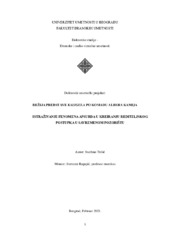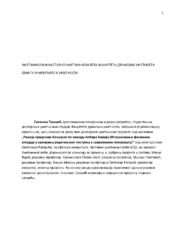| dc.contributor.advisor | Рапајић, Светозар | |
| dc.contributor.other | Вујић, Ивана | |
| dc.contributor.other | Стефановић, Бранислава | |
| dc.contributor.other | Павловић, Милош | |
| dc.contributor.other | Милин, Бошко | |
| dc.creator | Тришић, Снежана | |
| dc.date.accessioned | 2021-04-19T08:59:59Z | |
| dc.date.available | 2021-04-19T08:59:59Z | |
| dc.date.issued | 2021-10-21 | |
| dc.date.submitted | 2021-04-19 | |
| dc.identifier.uri | https://we.tl/t-O5DhoZGQCh | en |
| dc.identifier.uri | http://eteze.arts.bg.ac.rs/handle/123456789/511 | |
| dc.description.abstract | Predmet mog istraživačko-umetničkog rada i ove disertacije: „Istraživanje fenomena apsurda u kreiranju rediteljkog postupka u savremenom pozorištu” – utemeljen je na režiji predstave
Kaligula, po drami Albera Kamija u Narodnom pozorištu u Beogradu, koja je premijerno
izvedena 05.02.2020. godine. Ta predstava je glavni predmet istraživanja i analize, kao i
osnovno polazište i cilj ove disertacije. Autentičan metodološki pristup i zaključke probala sam da sprovedem i proverim i kroz analizu relevantnih svetskih predstava u savremenom pozorištu u prvom, uvodnom, delu rada.
Kroz analizu sadržinskih i formalnih sličnosti i razlika među dramama koje se smatraju
ključnim delima teatra apsurda, kao i kroz analizu filozofskog pojma – apsurd, probala sam da pronađem i definišem osnovne principe, elemente, sredstva i metodologiju rediteljskog
postupka u ovoj oblasti i primenim ih u režiji predstave Kaligula. Cilj ovog rada je da apsurd
kao filozofsku i apstraktnu kategoriju približim publici kroz konkretna i specifična rediteljska
sredstva, kao i da pronađem njegove komunikacijske kodove za publiku. Namera mi je da u
analizi i postavci apsurda na sceni, principom suptilne aktuelizacije, dekonstrukcije, citatnosti
kroz audio-vizuelnu inscenaciju i rediteljski postupak, istražim i scenski izrazim fenomen
apsurda u kontekstu savremenog društva, čoveka i pozorišta.
U prvom delu rada poseban fokus stavila sam na rediteljski postupak u savremenom pozorištu, gde kroz razlličite relevantne primere savremenog pozorišta izvodim, raščlanjujem i preispitujem elemente svog metodološkog pristupa kojim ću se kasnije detaljno baviti na
primeru predstave Kaligula u trećem i četvrtom delu rada. U prvom delu bavila sam se
značajem, mogućnostima i osnovnim elementima rediteljskog postupka u pozorišnoj režiji, kao i definisanjem pojma „savremeno“ pozorište i „rediteljski postupak“. Faze realizacije
rediteljskog postupka predstavljaju uvod u sledeći deo rada u kome se podrobnije bavim
fenomenom – apsurda.
U drugom delu rada kroz analizu života i dela pisca Albera Kamija, njegovog opusa, kao i
filozofskog i dramskog pravca kojima pripada, istražujem i fenomen apsurda. U ovom delu rada osvrćem se na četiri pravca važna za analizu apsurda: egzistencijalizam, filozofska drama, filozofija apsurda, drama i pozorište aspurda. Kroz njih izvodim ključne elemente za
razumevanje, prepoznavanje i realizaciju apsurda na sceni jer kroz ovaj umetničko-istraživački proces i predstavu želim da uspostavim apsurd kao jedan od najznačajnijih fenomena savremenog doba, moderne umetnosti i pozorišta.
U trećem delu razmatram metodologiju i faze rada, ali i uspostavljam postupak uz pomoć kojeg prelazim sa dramskog teksta i istorijskog konteksta na stvaralački deo predstave Kaligula. Kroz tumačenje naslova, bavim se analizom i kreacijom naslovne uloge komada, a zatim to dovodim u vezu sa tumačenjem i postavkom cele predstave u savremenom kontekstu. U ovom delu sagledavam lik Kaligule iz različitih perspektiva i izdvajam najznačajniju građu za celokupno kreiranje glavne uloge, kao i cele predstave.
U četvrtom delu razmatram apsurd kroz nastanak, razvoj i postavku jednog odabranog
rediteljskog postupka. U ovom delu bavim se analizom osnovnih elemenata drame kroz
definisanje i tumačenje osnovnih kategorija pozorišne režije: teme, ideje, sukoba. U ovom delu uglavnom se fokusiram na stvaralački deo rediteljskog rada i procesa, pa samim tim on
predstavlja centralni i najvažniji deo ovog rada. Probala sam da izvedem i prikažem jedan
mogući metodološki pristup kreiranja rediteljskog, a u ovom slučaju i rediteljskoscenografskog postupka.
U petom delu kroz zaključna razmatranja navodim osnovne faze praktičnog rada. Tu izdvajam određene elemente koji su mi koristili u radu i komunikaciji sa sardanicima i glumcima u svim fazama. Uz to prilažem autentičnu prepisku, materijal koji dokumentuje trag zajedničkog stvaranja i procesa, kao primer i put ka razjašnjenju, razradi i osmišljavanju glavne scene u komadu. U ovom delu izvodim zaključke koji su nastali u odnosu na proces i rezultat rada, kao i njegov prijem kod publike i kritike, a sve to u cilju preispitivanja prepoznatljivosti, čitljivosti, dometa i dejstva rediteljskog postupka i apsurda, koji su razmatrani ovom u radu i uspostavljeni u predstavi.
Istražujući genezu nastanka i razvoj apsurda u filozofskoj i dramskoj literaturi, kao i njegov
veliki značaj i uticaj na određene savremene rediteljske poetike i pravce, savremenu dramu i
pozorište, umetnički deo mog doktorskog rada bazirala sam na režiji predstave Kaligula, po
istoimenoj drami Albera Kamija. Ova disertacija nastala je zahvaljujući iskustvu, istraživanju
i umetničko-praktičnom procesu koji sam prošla sa autorskim timom, glumcima i saradnicima, kao i ozbiljnoj produkciji i podršci Narodnog pozorišta u Beogradu. Zajednički rad, znatiželja, podrška, posvećenost i kreativnost veoma su uticali na istraživačko-umetničke domete celokupnog rada i ove doktorske disertacije. | en |
| dc.description.abstract | The subject of my artistic research and this dissertation: “Exploring the phenomenon of
absurdity in creating a directing procedure in contemporary theater” – is based on the directing of the play Caligula, based on the play by Albert Camus at the National Theater in Belgrade, which premiered on 5th February 2020. This play is the main subject of my research and analysis, as well as the basic starting point and the aim of this dissertation. In the first,
introductory part of this thesis, I tried to implement and verify the authentic methodological
approach and conclusions through the analysis of relevant world plays in contemporary theater.
Through the analysis of content and formal similarities and differences between plays
considered to be key works of the theater of the absurd, as well as through the analysis of the
philosophical concept – the absurd, I tried to find and define basic principles, elements, means and methodology of directing in this field, and to apply them while directing Caligula. The aim of this work is to bring the absurd as philosophical and abstract category closer to the audience through concrete and specific directing tools, as well as to find its communication codes for the audience. My intention is to, by analyzing and setting of the absurd on the stage, through the principle of subtle actualization, deconstruction, citation through audio-visual staging and directing, explore and present the phenomenon of the absurd in the context of modern society, man and theater.
In the first part of the paper, I put a special focus on the directing procedure in contemporary
theater, where through various relevant examples I derive, analyze, and review elements of my methodological approach, which I later develop in detail on the example of Caligula in the third and fourth part. The focus of the first part is on the meaning, possibilities, and basic elements of the directing procedure in theater, as well as on defining the term ‘contemporary’ theater and ‘directing procedure’. The stages of realization of the directing procedure represent an introduction to the next part of the work in which I treat in more detail the main phenomenon – the absurd.
In the second part of the paper, through the analysis of the life and work of the writer Albert
Camus, his opus, as well as the philosophical and theater movement to which he belongs, I also explore the phenomenon of the absurd. In this part I look at four movements important for the analysis of the absurd: existentialism, philosophical drama, philosophy of the absurd, drama and the theater of the absurd. Through them I derive key elements for understanding,
recognizing and realizing the absurd on the stage, because through this artistic research process and deduction I want to establish the absurd as one of the most important phenomena of the modern times, modern art and theater.
In the third part I discuss the methodology and phases of the work, but I also establish the
procedure which allow the move from dramatic text and the historical context to the creative
part of the play Caligula. Through the interpretation of the title, I deal with the analysis and
creation of the leading role in the play and then I connect that with the interpretation and setting of the whole play in a contemporary context. In this part I look at the character of Caligula from different perspectives and single out the most important material for the overall creation of the protagonist role as well as the entire play.
In the fourth part I discuss the absurd through the origin, development and setting of a selected directing procedure. In this part I provide the analysis of the basic elements of drama through the definition and interpretation of the basic categories of theater directing: themes, ideas, conflicts. In this part I mainly focus on the creative part of the director’s work and process so it represents the central and most important part of this work. I tried to derive and present one possible methodological approach to creating a directing procedure and, in this case, a directing scenography procedure.
In the fifth part through concluding remarks I list the basic phases of practical work. Here I
single out certain elements that I found useful throughout my working process and
communication with co-workers and actors during all phases. In addition, I enclose authentic
correspondence, the material that documents traces of joint creation and process, as an example and a way towards the clarification, elaborating and devising of the main scene in the play. In this part I draw conclusions concerning the process and the result of the work, as well as its reception by the audience and the critics in order to review the recognition, readability, scope and effect of the directing procedure and absurdity established in the play.
Exploring the genesis and development of the absurd in philosophical and dramatic literature
as well as its great significance and influence on certain contemporary directing poetics and
movements, contemporary drama and theater, I based the artistic part of my doctoral work on
the play Caligula, based on the play of the same name by Albert Camus. This dissertation was
created thanks to the experience, research and artistic and practical process that I went through with the author’s team, actors and collaborators, as well as the serious production and support of the National Theater in Belgrade. Joint effort, curiosity, support, dedication and creativity have greatly influenced the research and artistic achievements of the entire working process and this doctoral dissertation. | en |
| dc.language.iso | sc | en |
| dc.publisher | Универзитет уметности у Београду, Факултет драмских уметности | sr |
| dc.source | Факултет драмских уметности | sr |
| dc.subject | pozorišna režija, rediteljski postupak, apsurd, egzistencijalizam, pozorište apsurda, Alber Kami, Kaligula, savremeno pozorište | en |
| dc.subject | theater directing, directing procedure, absurd, existentialism, theater of the absurd, Albert Camus, Caligula, contemporary theater | en |
| dc.title | Режија представе "Калигула" по комаду Албера Камија (Истраживање феномена апсурда у креирању редитељског поступка у савременом позоришту) | en |
| dc.type | other | en |
| dcterms.abstract | Rapajić, Svetozar; Vujić, Ivana; Pavlović, Miloš; Milin, Boško; Stefanović, Branislava; Trišić, Snežana; Režija predstave "Kaligula" po komadu Albera Kamija (Istraživanje fenomena apsurda u kreiranju rediteljskog postupka u savremenom pozorištu); | |


